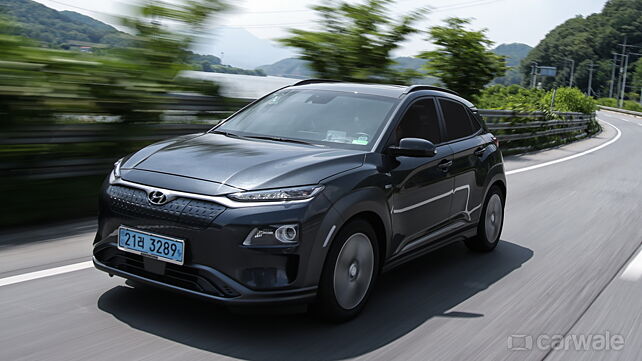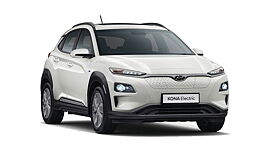What is it?

Why will I buy it?
Sublime, silent driving experience, eco-friendly and economical to run
Why will I avoid it?
Charging options are still a question mark.

The Kona, on its own, has been around for a while now and has always been a smart looking crossover. The EV version gets subtle changes to stand out. In keeping with the current trend, its got DRLs placed where the headlights should be whereas the headlights have been moved further below. As is the case with the Ioniq, there is no grille here, just a flat plastic which opens up at one corner for the charging module. The sides get typical flat alloy wheels for better aerodynamics and plastic cladding all across which gives it a butch SUV feel. Overall we liked how the Kona looks and once here, it will be one of the better looking compact crossovers.
How is it on the inside?

While it may not look like a quirky EV from the outside, the futuristic insides do make you feel like you have climbed into something different. It’s a very clean layout and very practical too. There is a big 8-inch screen popping out of the dash that takes care of the infotainment system and the other vehicle settings. The bridge type centre console is very smartly designed and even has storage space below it. Instead of a gearstick to select the drive, this car has a button type gear shift which works great. Overall the quality of plastics and the soft touch material feels quite premium and is quite likeable.
Powered seats means getting the right driving position is easy. The seat itself is quite comfy and offers good support all around. We didn't get the opportunity to try the rear seats. However, even though the Kona might not be the most spacious in its segment, it should squeeze in 3 people decently well.
How does it drive?

The most important aspect for the Kona will be how it feels on the road and luckily we got to drive it on the public roads of Korea. The route was a mix of city and highways and because we got lost for a little while, we got some narrow congested lanes as well.
The Kona EV that we were driving came with a 39.2 kWh battery. With a whopping 395 Nm of torque available from the word go, these are serious figures for a compact crossover, EV or not. The Kona also gets driving modes to choose from. There is Eco plus, Eco, Comfort and Sport. We mostly drove on Comfort and Sport modes since these two would be the most widely used ones.

Even in Comfort mode, the Kona has more than adequate performance. Whether it be overtaking long trucks, making that quick gap or just getting on with it, the motor responds with a linear but powerful surge and just keeps pulling. We did not go anywhere near the estimated top speed of 167 kmph, but that’s because Korea is extremely strict with its speeding laws. But we have no doubt that the Kona will get there with ease.
Shifting to Sport mode, the Kona becomes a different animal. The acceleration is strong enough to scare your co-passenger as it did mine and flooring the accelerator even at speeds above 60 kmph gets the wheels spinning. It’s really addictive stuff and whoever said EVs are boring should get a load of this.

Now to the more important point - its range. Hyundai claims it to be over 400 km and that’s what the dash showed when we began the drive. Even after trying all the modes and some hooligan driving in Sport mode with the aircon on at all times and covering some 140 odd km, the Kona still showed over 220 km of range left which was fantastic. This pretty much means that if you are driving in a sane manner, the Kona will cover the claimed range.
But, then again, this is the Korean-spec Kona which is level two autonomous and gets lane following assist, speed limit warning, smart cruise control with stop and go assist, front collision avoidance and then some. These features will be missing in the Indian car. Also the power output along with the range will differ vastly. But, as to how big a number that will be, still remains to be seen.

Should I buy one?

As a car the Kona is fantastic. It drives extremely well, has a plush cabin and knowing Hyundai, it will come with a bunch of features. But what Hyundai still has to provide reassurance for is the charging bit and that's an important one. For now Hyundai aims to set up quick chargers at dealerships that should charge the car in under an hour. Regular slow charging takes up an excess of 6 hours.
But, then again, for a charging station you will need to own a house where the charging station can be installed. And that won’t be possible in a regular building in a common parking lot and therein lies the problem. Until Hyundai and the government come up with a better solution, the Kona will be bought by the privileged few only and that is also one of the reasons why the Kona will be launched in a few select metro cities only. While this is definitely the start of good things to come, we common folk will still have to wait a while before we can lay hands on a full range electric that can be charged from our humble abodes.

Where does it fit in?
The Kona will come in CKD trim and should be priced around Rs. 25-30 lakhs, when launched next month. Presently, the only competition to this car seems to be the Toyota Prius Hybrid.

































